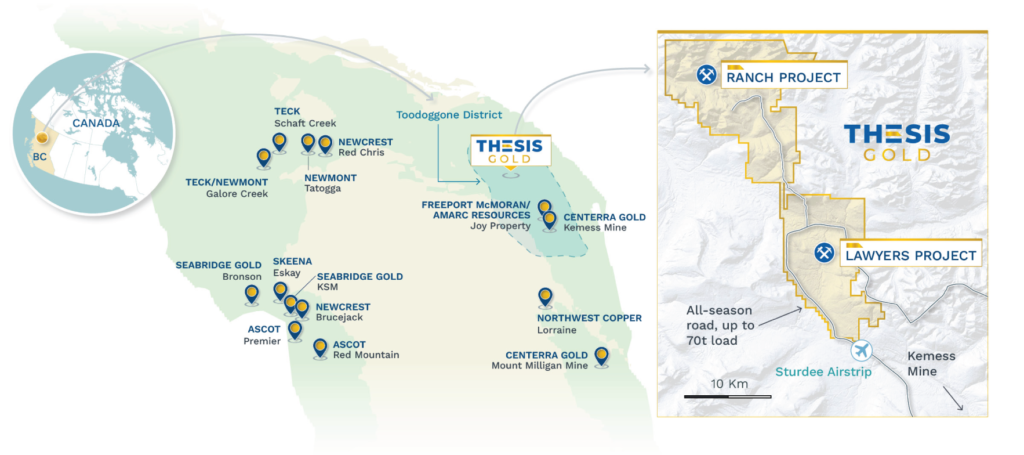Thesis Gold (TSXV: TAU; US-OTC: THSGF) says its latest drill results expand mineralization in the JK zone at the Ranch project in north-central British Columbia.
The results lengthened mineralization along north-south trending structures in the JK zone to 230 metres from 60 metres at the project southeast of Dease Lake, Thesis said on Wednesday.
Drillhole 23JKDD001 returned 20 metres grading 2.93 grams gold per tonne; drillhole 23JKDD011 returned 9.37 metres at 2.03 grams; and drillhole 23JKDD005 intercepted 69.83 metres grading 1.28 grams.
Mineralization remains open to the north while a potential structure offsets mineralization to the south, the company said. The zone is 270 metres south of the main access road midway between the Thesis Structural Corridor and the Bonanza-Ridge zone.
“The JK Zone has grown significantly in strike length, exhibits near surface high-grade mineralization and remains open for testing in 2024,” president and CEO Ewan Webster said in the release. “The expansion of mineralization and the identification of new targets underscore our commitment to realizing the full potential of the Ranch project.”
The project vies with others by giant Newmont (TSX: NGT; NYSE: NEM) and Centerra Gold (TSX: CG; NYSE: CGAU) in the Golden Horseshoe area about 750 km north of Vancouver. Thesis merged with Benchmark Metals in June to become one of the Toodoggone mining district’s largest explorers.
Shares in Thesis Gold gained 3.5% on Wednesday to 60¢ apiece, valuing the company at $97.8 million. Over the last year the company has traded in a range of 40¢ and $1.09.

Lawyers project
Ranch is road-accessible via the Lawyers Gold-Silver project, which Benchmark was developing before the merger. The two projects form a contiguous 325-sq.-km property. Lawyers has 67.4 million measured and indicated tonnes grading 1.2 grams gold, 22.9 grams silver for contained metal of 2.5 million oz. gold and 49.6 million oz. silver, according to a preliminary economic assessment issued in June 2022.
The mine would cost $493 million to build, for annual production of 169,000 gold-equivalent oz. over a 12-year mine life at all-in sustaining costs net of by-products of US$824 per oz., Benchmark said.
Exploration at Ranch began in the early 1970s before surface mining in 1991 produced 10,000 oz. gold over a year. However, the site wasn’t further developed after that.
Wednesday’s results have helped understanding of the sparsely drilled zone that shows the importance of north-south oriented faults as controls on hydrothermal fluids and mineralization, the Vancouver-based explorer said.
Gold mineralization in drill hole 23JKDD011 supports the offsetting influence of northwest to southeast faults on the north-south structures and will be the subject of further testing next year. Like the Steve zone, JK is an early-stage target with opportunity for continued expansion, Thesis said.


Be the first to comment on "Thesis Gold grows Ranch project in northern BC"